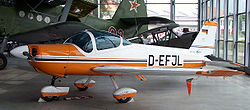Bölkow Bo 209
| Bölkow 209 "Monsoon" | |
|---|---|

|
|
| Type: | Light aircraft |
| Design country: | |
| Manufacturer: | |
| First flight: |
22nd December 1967 |
| Production time: |
1967-1972 |
| Number of pieces: |
> 100 |
The Bölkow Bo 209 "Monsun" is a two-seat light aircraft produced by the German aircraft manufacturer Bölkow GmbH . A special feature of the cantilever all - metal low- wing aircraft are the foldable wings , which means that it can be transported like a car trailer.
origin
The Bo 209 is the successor to the Bölkow 208 Junior , a license build of the MFI-9 Junior from Malmö-Flygindustri (MFI) from Sweden . In 1965 the decision was made to independently develop a successor to the Junior. Hermann Mylius presented his drafts together with a development cost estimate of 1.2 million marks to the MBB board, which, however, refused. The "Monsun" was created in 1966, when Hermann Mylius, Walter Heynen and Johann Kraus founded the "Light Aircraft Development Group" in Brunnthal on September 6, 1966 . There the project was named MHK 101. The project was supported by Ludwig Bölkow and other engineers from the Bölkow company from Ottobrunn joined the group. After almost two years of development, the prototype MHK 101 V0 with a 115 hp Lycoming O-235 -C2A took off for its maiden flight in Laupheim on December 22, 1967 . At the 1968 aviation show in Hanover, the machine was shown at the Bölkow stand and was finally named the successor to the Bölkow 208. After numerous improvements ( e.g. Lycoming O-320 -B with 150 hp) and an in-depth market analysis, the aircraft went into series production under the official name Bo 209 Monsun in 1969 at the Laupheim plant after it was first demonstrated in May 1969 in Egelsbach. The Bo 209 received type certification on May 11, 1970.
The Monsun had unique features in its class: space-saving parking and transport thanks to the foldable surfaces, retractable nose wheel, low consumption and purchase price, high travel comfort and low noise levels.
The 209 was also offered in four different versions. The 209 S was a simplified training model with a rigid nose wheel, no flaps and a 115 hp engine. The top model was fully suitable for aerobatics and equipped with electric flaps, retractable nose wheel and a Lycoming O-320-D1A engine with 160 hp and a controllable pitch propeller.
Depending on the engine and equipment, the ex-works price ranged from DM 38,659 to DM 59,950
With this wide range of equipment features, Bölkow was able to convince at the 1970 Air Show in Hanover : 57 pre-orders of the new type were signed. The commercial success of the project seemed assured. In 1968, however, the merger of Bölkow GmbH into the MBB Group led to the basic economic decision to stop building civil aircraft. Although 102 Monsun were produced between 1969 and 1971 and there were still 275 orders on hand, MBB decided to stop production in February 1972. Attempts by Reinhold Ficht to continue production could not be realized.
The Bo 209 was still used as a template for the Mylius My 102 Tornado (a single-seat aerobatic plane with monsoon wings and AIO-360-B1B with 200 hp), which had its first flight on July 7, 1973 and a second later Copy was built.
Incidents
The majority of the 209 crashes are due to the aircraft stalling, mostly during take-off or landing. The wings of the Bo 209 monsoon have a high performance profile, which in combination with a back center of gravity (for example in luggage load behind the seats) to an abrupt stall tends. In some monsoons, a stall warning device was therefore retrofitted, which emits a warning tone if the flow to the surface is too steep.
In the mid-1980s, fatigue cracks on the wing spar of a machine during aerobatic maneuvers led to the breakage of a wing. As a result, all Bo 209s were temporarily put out of service for inspection.
Technical specifications
| Parameter | Data |
|---|---|
| crew | 1 |
| Passengers | 1 |
| length | 6.40 m |
| span | 8.40 m |
| Wing area | 10.2 m² |
| Empty mass | 515 kg |
| Max. Takeoff mass | 820 kg |
| Resilience | +6 / −3 g |
| Cruising speed | 259 km / h (140 kts) |
| Top speed | 275 km / h (149 kts) |
| Service ceiling | 4000 m (12000 ft) |
| Range | 1200 km |
| Rate of climb | 5.2 m / s |
| Engines |
Lycoming O-320 (Bo 209 FF and FR) Lycoming IO-320 (Bo 209 RV) Lycoming O-320 -D1A (Bo 209 S) |
See also
literature
- Günter Brinkmann, Kyrill von Gersdorff, Werner Schwipps: Sports and travel aircraft. Guidelines of diverse development . Bernard & Graefe, 1995, ISBN 3-7637-6110-1 .
Web links
- Official EADS website for Bo 209
- History of the 209
- www.german-historic-flight.de
- Photo documentation of the Bo 209 monsoon
- 209 on www.jetphotos.net
Individual evidence
- ↑ D-EBJP (CN: 156) Private MBB Bo209 Monsun by Björn Venghaus . jetphotos.net. Retrieved June 26, 2011.
